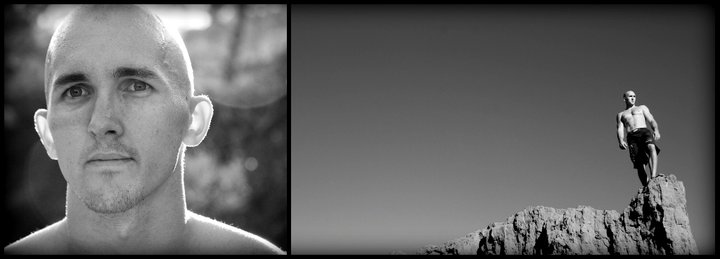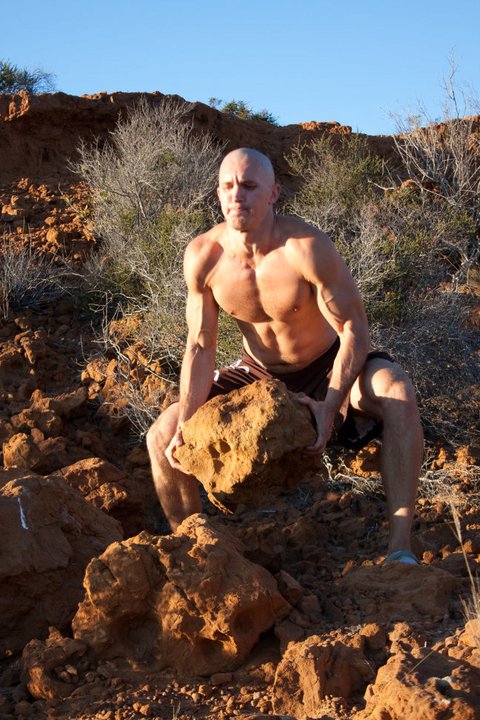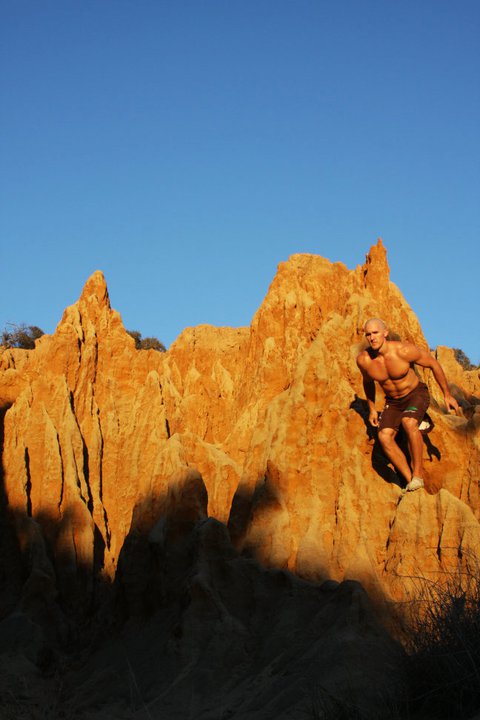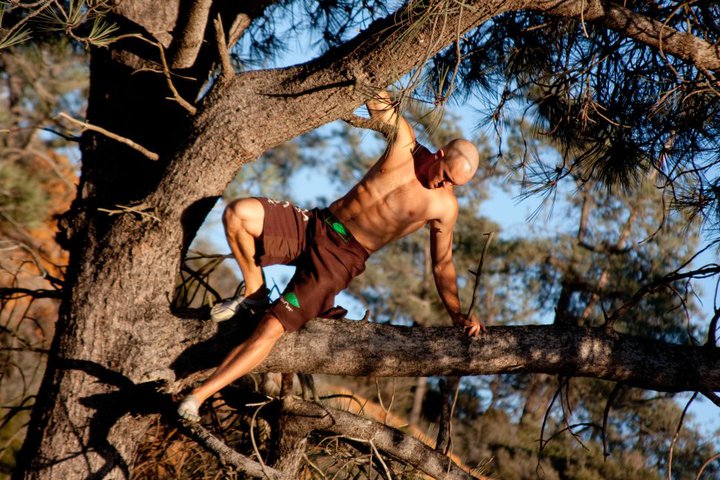
By now, you guys probably know that I’m a pretty big fan of MovNat, which is why I was ecstatic when one of MovNat’s top instructors agreed to an exclusive interview just for you. I want to introduce you to Clifton Harski, who is a MovNat Master-Level Instructor. Clifton is involved with many aspects of the MovNat mission, but he’s particularly well-known for conducting workshops around the country. In this interview, he shares a lot of great insight about the MovNat system. Enjoy!
John: Can you tell us a little bit about yourself including your background in athletics and fitness and also what you do today?
Clifton: I grew up playing lots of traditional sports in all corners of the world – karate, gymnastics, basketball, soccer, cricket, etc. and also just played/explored as well through hikes, playing tag, hide and seek. I didn’t grow up playing video games basically! I managed to be named the athlete of the year in my high school, and went on to play a little junior college basketball. I got my degree in Kinesiology in 2005, but didn’t start really working in the fitness industry until 2009 (I managed at Trader Joes for 5 years). I feel this is an advantage because I tried out TONS of training methodologies and learned from all of them instead of pigeon holing myself into one specialty. In 2010, faced with the potential of being the top manager at a store, I decided to quit my management position and go for it in the fitness industry. I gathered letters to put after my name, ACE PT, RKC, UAC360 combine trainer, and CF level 1 to add to my degree in Kinesiology. I also attended a 5 day MovNat workshop in the summer of 2010.
 What drew you to MovNat originally, and what happened to you in West Virginia in the summer of 2010?
What drew you to MovNat originally, and what happened to you in West Virginia in the summer of 2010?
Initially I was made aware of MovNat through a Mens Health article I had read. It sounded really intriguing and so I decided that if I had the opportunity to try it, I would. Well, I looked online and 1 spot was left so I committed to it, and it worked out pretty well I think! As far as what happened to me, it was another evolution of how I saw what training could be. The first evolution was from reductionist bodybuilding type training into so called “functional” training. This took it another step by challenging your movement competency in new situations. That really had me intrigued.
In your own words, what is MovNat?
MovNat is a real-world movement competence coaching and training system where we define fitness on what your body can do. I and we believe that the human body is designed to function in other places than just the gym.
Given your background in CrossFit, how does MovNat differ from that system, and do they share any similarities?
I don’t really have an extensive background in CF. I have my cert, but I wouldn’t be the first in admitting that having the cert doesn’t mean a whole lot (I still really do respect the original CF ideas and methods, but the lack of quality control and emphasis on asskicking don’t resonate with me). I believe they are similar in that both MovNat and CF seek to develop a more comprehensive physical being, but the two systems divert in that CF focuses on capacity for capacity’s sake, while MovNat’s focus is on high level movement skills. Capacity will be built from practicing quality movement, but the opposite is not actually true. Physical qualities stem from the broad practice of all human movement skills, but one doesn’t acquire actual movement skills by primarily focusing on physical conditioning. For instance if you never climb rocks or tress, it doesn’t really matter how many pull-ups you can do in a row, you won’t move so well and might waste ton of energy in the process, because you lack skill. If you train your climbing skill in a broad manner though, you will acquire all the specific conditioning or capacity associated with that particular skill, and I’d bet you’d be great at pull-ups too.
A common criticism of CrossFit is that it claims to physically prepare you for anything and everything. This is obviously impossible, but in your experience, how does CrossFit compare to MovNat in regards to preparing for unpredictable future circumstances? And what does MovNat do differently to ensure optimal preparation?
While CF does state that they are constantly varying, very little variance is actually found in the skills performed. The set/rep schemes are constantly varied, however the things they lift, the movements required in WODs are generally the same 10 or so movements. Life has more options than that. What MovNat does to prepare for unpredictable future circumstances is to encourage changing the circumstances in which you train, i.e environmental or situational demands.
Again, for instance being able to perform several pull-up in a row doesn’t significantly improve your aptitude to climb. We address what we call the “breadth of specificity”, we train skills in a broad, but also specific manner.
For instance, we’ve seen guys who could do plenty of pull-ups barely able to pull themselves up when given a much thicker bar, because they lacked grip. They get challenged by a new environmental demand which they are not prepared for. Now to us the goal won’t be to just pull our body up, but to actually climb on top, without falling, fearing, or slowing down. And to achieve this, you need more “conditioning” than just pull-ups, you need several technical options and the specific physical conditioning you will acquire while training those techniques. You see, we address not just capability in a broad sense, but adaptability. To us, and I’ll quote Erwan here, adaptability is the real measure of physical capability.
But, it’s very important that safe, efficient, and quality movement always precede intensity or volume. We will ultimately build better capacity if we try to layer it on top of technical proficiency vs just pushing yourself hard.
 A little birdy told me you like eat meat and lift heavy stuff, particularly kettlebells. How do you balance your MovNat training with other strength training, if at all?
A little birdy told me you like eat meat and lift heavy stuff, particularly kettlebells. How do you balance your MovNat training with other strength training, if at all?
I do like those things! I actually feel that classical strength training fits under the scope of MovNat. Lifting and carrying are components of MovNat, we just don’t ONLY use barbells. We use barbells, kettle bells, sandbags, rocks, logs, people, and anything else which we can train with safely. It doesn’t make it a separate training, it is MovNat, since MovNat involves all manipulative skills like lifting, carrying, throwing or catching, and regardless of the kind of object you deal with. For instance, what is the practical meaning of a Kettlebell swing after all? It is the action of throwing or catching, only that you don’t let go of your hold, and therefore, can train without a partner.
I train MovNat for about 16 hours each weekend while coaching, plus more during the week based on my travel schedule. I throw in some classic S&C stuff too, again depending on where I’m at and who is asking me to train with them. That also can be seen as MovNat, but only an advanced MovNat practitioner should start training in such specific manners. Personally, I find kettlebell training to be fun. So I do that. The best form of training for anyone is the form which they enjoy because that means they will actually do it. If there was one perfect training routine, but it was absolutely miserable, nobody would see benefit from it because they wouldn’t do it!
MovNat teaches a broad collection of movements based on the 12 main human movement skills (walking, running, jumping, balancing, crawling, climbing, lifting, carrying, throwing, catching, swimming, and defending). One could argue that MovNat trains you to become a movement generalist. Would you agree, and if so, what is the value of becoming a movement “generalist” rather than specializing in a few different movement skills?
I agree. Unless you make your living on being a specialist, or have a very specific goal, being a generalist makes so much more sense than adding 5 lbs to your snatch at the expense of being able to climb, run, jump, swim etc.
In your experience, do most people really need to relearn such fundamental movements like how to walk and run? If so, why do you think this is?
Thinking that what is natural to us cannot be learned and taught is a romantic view. That is far from the truth. Yes, the capacities we coach and train are natural and to some extent instinctive. Anyone can go “explore their true nature” and run, jump, climb or carry something for instance, but the question is, can everyone do it with efficiency? Natural does not equal efficient. Efficient means highest performance possible, lowest energy-expenditure and safest action possible, and this only comes naturally to a minority of lucky individuals. To most of us, including MovNat founder Erwan Le Corre, it is the outcome of a learning process and a consistent, mindful practice based on movement efficiency principles and techniques. Now, sit in a park and watch the people walking and running in it – absolutely they need help! Years of misuse and disuse have left the majority of the population broken, frail, or on the verge of being those.
 Since MovNat integrates such a diverse selection of movement skills ranging from swimming to fighting to various locomotive movements, how does this take shape as a comprehensive training program on a day-to-day and week-to-week basis? Surely there are lots of ways to do it, but are there any, in particular, that you have found to be most effective?
Since MovNat integrates such a diverse selection of movement skills ranging from swimming to fighting to various locomotive movements, how does this take shape as a comprehensive training program on a day-to-day and week-to-week basis? Surely there are lots of ways to do it, but are there any, in particular, that you have found to be most effective?
Starting with the most fundamental things should be a priority: posture and breath. After that, my personal opinion is that crawling (moving on all fours, and other ground based movement) and climbing go a huge way into helping people regain movement. This may have a lot to do with those being two movements which we did first in our lives, and if we are indeed relearning how to move well, then it makes sense that restarting at the beginning is so beneficial. Beyond that, you need to learn how to customize a MovNat training plan based on your individual needs and objectives, but also your personal possibilities and limitations.
If you had just a half an hour to train each day, what would you do?
Figure out what went wrong in life! But I’ll play along – I would do various crawling and ground movements, climb stuff, and pick up and carry things. Each day would be a different combo of those. There is a lot you can explore on your own, but if you train with us you will save an enormous amount of time by learning movement efficiency in a short time.
How could someone get started with MovNat today?
Without proper instruction, the idea of “just going outside and playing” can be a good or bad recommendation. I think that simple things like hiking on a trail that isn’t paved, swinging on monkey bars, and crawling through the playground are things that could be done right away, if you are able to moderate yourself, use common sense, and not be a jackass. Otherwise come to a workshop and truly revolutionize your movement aptitudes :)
Where can my readers find more information about you and the MovNat revolution?
www.MovNat.com is a great spot, and we are adding more content each week. On the site is where you can sign up for our newsletter, see the calendar of where we will be holding workshops, and follow our growth. Also you can follow us on Twitter @movnat and also on Facebook.
Wrap-Up
A big thanks to Clifton for doing this interview. You shared a lot of valuable info, and I’m sure it will bring some new people to the MovNat cause. I’m looking forward to meeting you for some food and training someday!
To learn more about Clifton Harski and the work he’s doing, check him out on Twitter and Facebook. And if you’re thinking of attending a MovNat seminar (highly recommended), check out my review of the 5-Day Expansion Workshop to get an idea of what to expect.
More MovNat info coming in the future!
If you found this article helpful, please share it with your friends and tweeps:
.jpg)
![]()
CST Coach, CST-KS
Health-First Fitness Coach
MovNat Alumni – Summersville Lake, WV (2009)
Great set of questions asked there. I’ve had a tough time constructing my own MovNat-sessions since I attended a workshop earlier this year, and this actually made me take a new shot at this. My MovNat sessions right now are a lot more haphazard than I’d like..
Thanks for putting together a great interview!
// D
My pleasure, DB. I’m glad to hear it’s reignited some energy – even haphazard training comes with benefits.
Hey John, great interview thanks! I just thought I’d ask that in future if you or people you interview use abreviations if you could expand on these that’s be great. For example: ‘I throw in some classic S&C stuff too’. There were a couple other ones also. I think this would be a great addition to your great blog : )
Thanks Ross – good feedback.